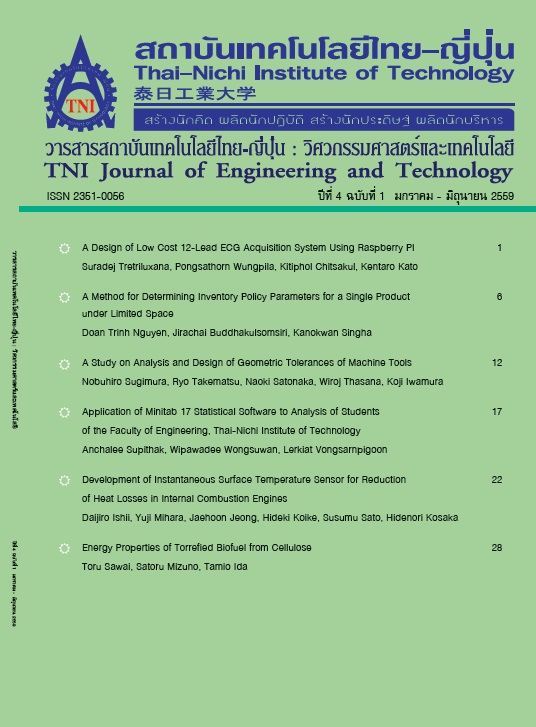Laser Peening for Surface Enhancement of Stainless Steel
Main Article Content
Abstract
Surface enhancement of stainless steel by laser peening has been studied. Especially, in this study, effects of control of plasma confinement layer on have been investigated. The plasma confinement layer for the laser peening is usually used the transparent medium to the laser wavelength, such as a glass and water. The confinement ability depends on the acoustic impedance of the medium. In this study, the acoustic impedance of the water has been controlled by dissolving sodium chloride (NaCl). Second harmonic of Nd:YAG laser having the pulse duration of 4 ns has been used for the laser peening experiments. Commercial SUS316L stainless steel has been adopted as a sample. The samples were investigated under nanosecond laser shock loading in plasma confined by aqueous sodium chloride solution. Vickers hardness test and X-ray diffraction method are used to probe work hardening and residual stress due to plastic deformation induced by laser peening. Through hardness and residual stress measurements, it is found that optimal concentration of the sodium chloride solution has been existed for the laser peening.
Article Details
Article Accepting Policy
The editorial board of Thai-Nichi Institute of Technology is pleased to receive articles from lecturers and experts in the fields of engineering and technology written in Thai or English. The academic work submitted for publication must not be published in any other publication before and must not be under consideration of other journal submissions. Therefore, those interested in participating in the dissemination of work and knowledge can submit their article to the editorial board for further submission to the screening committee to consider publishing in the journal. The articles that can be published include solely research articles. Interested persons can prepare their articles by reviewing recommendations for article authors.
Copyright infringement is solely the responsibility of the author(s) of the article. Articles that have been published must be screened and reviewed for quality from qualified experts approved by the editorial board.
The text that appears within each article published in this research journal is a personal opinion of each author, nothing related to Thai-Nichi Institute of Technology, and other faculty members in the institution in any way. Responsibilities and accuracy for the content of each article are owned by each author. If there is any mistake, each author will be responsible for his/her own article(s).
The editorial board reserves the right not to bring any content, views or comments of articles in the Journal of Thai-Nichi Institute of Technology to publish before receiving permission from the authorized author(s) in writing. The published work is the copyright of the Journal of Thai-Nichi Institute of Technology.
References
K. Ding and L. Ye, Laser Shock Peening. n.p.: CRC Press, 2006.
Y. Sano, N. Mukai, K. Okazaki, and M. Obata, “Residual stress improvement in metal surface by underwater laser irradiation,” Nuclear Instruments and Methods in Physics Research Section B: Beam Interactions with Materials and Atoms, vol. 121, no. 1, pp. 432–436, Jan. 1997.
A. H. Clauer, J. H. Holbrook, and B. P. Fairand, “Effects of Laser Induced Shock Waves on Metals,” in Shock Waves and High-Strain-Rate Phenomena in Metals, M. A. Meyers and L. E. Murr, Eds. Springer US, 1981, pp. 675–702.
P. Peyre and R. Fabbro, “Laser shock processing: a review of the physics and applications,” Opt Quant Electron, vol. 27, no. 12, pp. 1213–1229.
X. Hong, S. Wang, D. Guo, H. Wu, J. Wang, Y. Dai, X. Xia, and Y. Xie, “Confining medium and absorptive overlay: Their effects on a laser-induced shock wave,” Optics and Lasers in Engineering, vol. 29, no. 6, pp. 447–455, Jun. 1998.
R. Fabbro, J. Fournier, P. Ballard, D. Devaux, and J. Virmont, “Physical study of laser‐produced plasma in confined geometry,” Journal of Applied Physics, vol. 68, no. 2, pp. 775–784, Jul. 1990.
Y. Sano, “Residual Stress Improvement by Laser Peening without Coating and Its Applications,” in The 65th Laser without protective coating,” Materials Science and Engineering: A, vol. 417, no. 1–2, pp. 334–340, Feb. 2006. Materials Processing Conference, 2005, pp. 1–6.
Y. Sano, M. Yoda, N. Mukai, M. Obata, M. Kanno, and S. Shima, “Coating and Its Applications,” Journal of the Atomic Energy Society of Japan, vol. 42, p. 567, 2000.
Y. Sano, N. Suezono, Y. Yoda, M. Mukai, and K. Ogawa, “Special Technical Publication,” Materials Science Research International, vol. 2, p. 453, 2001.
Y. Sano, M. Obata, T. Kubo, N. Mukai, M. Yoda, K. Masaki, and Y. Ochi, “Retardation of crack initiation and growth in austenitic stainless steels by laser peening without protective coating,”Materials Science and Engineering: A, vol. 417, no. 1–2, pp. 334–340, Feb. 2006.
Y. Sano, T. Corporation, and K. Akita, “Laser Peening without Coating as a Surface Enhancement Technology,” Journal of Laser Micro/ Nanoengineering, vol. 1, no. 3, pp. 161–166, 2006.
B. Pal and S. Kundu, “Anomalous Ultrasonic Attenuation in Aqueous NaCl Solutions,” Universal Journal of Chemistry, vol. 1, no. 3, pp. 69–101, 2013.
R. W. Potter and D. L. Brown, Preliminary Steam Tables for Nalco. n.p.: Solutions, 1977.
M. R. James and J. B. Cohen, The Measurement of Residual Stress by X-ray Diffraction Techniques. n.p., 1980
R. Fabbro, P. Peyre, L. Berthe, and X. Scherpereel, “Physics and applications of laser-shock processing,” Journal of Laser Applications, vol. 10, no. 6, pp. 265–279, Dec. 1998.


